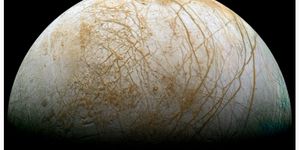Pluto's Atmosphere is Preserved in Part by Charon
Unlike most of the planets in the Solar System, Pluto, which is actually a dwarf planet, has a moon dubbed Charon that’s well over half of its own diameter and orbits the body very closely, at less than 12,000 miles away.
This unique characteristic gives Charon an incredible amount of influence over Pluto, as its sheer size makes it a functional companion. One of the things that makes it functional is how it works as a shield to protect Pluto’s thin atmosphere.
Image Credit: NASA
Published in the journal Icarus, researchers have revealed how Charon can actually help protect the dwarf planet’s atmosphere from completely fading away from solar wind activity. This is a type of radiation that comes from our Sun, and yes even at a distance as far as Pluto, solar wind can strip a planet’s atmosphere away.
It turns out that when Charon, as large as it is, gets in between Pluto and the Sun during a bout of solar wind, it keeps all of those charged particles from hitting Pluto, and the moon takes the brunt of the activity instead.
It’s worth noting how this is only the case when Charon has an effective atmosphere, which isn’t all the time. That said, Charon isn’t a completely fail-safe shield for Pluto; it’s only slowing the deterioration of Pluto’s thin atmosphere down when the conditions are right.
When the atmosphere is available, it redirects some of that solar wind away, similarly to the way Earth’s vibrate atmosphere keeps us safe from particles that come from solar winds.
Other situations where Charon is ineffective as a shield are when solar winds strike Pluto when Charon is behind Pluto or somewhere off to the side, as it can obviously only work as a shield when it’s in between Pluto and the Sun and working as a blockade.
Learning more about Pluto’s atmospheric conditions as a whole is important to space researchers because being so far away from the Sun, Pluto has the potential to be a time capsule of the elements that existed in the early solar system.
Pluto still has more of its volatile elements, which have long since been blown off the inner planets by solar wind,” study co-author and Georgia Tech study John Hale said.
“Even at its great distance from the sun, Pluto is slowly losing its atmosphere. Knowing the rate at which Pluto’s atmosphere is being lost can tell us how much atmosphere it had to begin with, and therefore what it looked like originally. From there, we can get an idea of what the solar system was made of during its formation.”
For what it’s worth, Pluto isn’t losing its atmosphere as quickly as we thought, and that means there’s still a wealth of information there to be discovered.
Source: Science Daily









